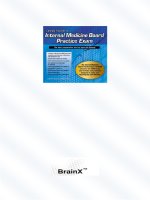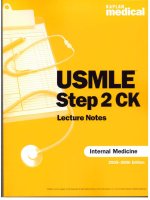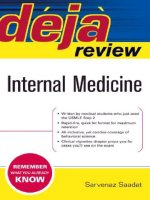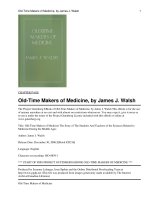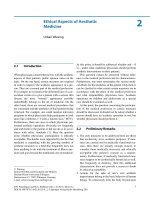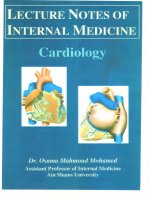Lecture Notes Of Internal Medicine ppt
Bạn đang xem bản rút gọn của tài liệu. Xem và tải ngay bản đầy đủ của tài liệu tại đây (3.07 MB, 138 trang )
I.
2.
3.
4.
5.
6.
7.
8.
9.
10.
II.
12.
13.
14.
15.
16.
17.
18.
19.
20.
21.
22.
23.
24.
25.
26.
27.
28.
29.
30.
31.
Index
Anatomy .
Investigations .
Heart Failure .
Cardiogenic pulmonary edema .
Different classification of heart failure .
Systemic Hypertension .
Especial problems with hypertension .
Hypertensive encephalopathy .
Ischaemic heart Diseases (LH.D) .
Angina Pectoris .
Myocardial Infarction .
Arrhythmia .
Cardiac Arrest .
Rheumatic Fever .
Infective Endocarditis .
Pericardial Diseases .
Cardiomyopathy .
Myocarditis .
DVT & Pulmonary Embolism .
Diseases of Aorta .
Congenital Heart Disease .
<
Heart Diseases with Pregnancy .
Mitral Valve Disease .
Left Atrial Myxoma .
Mitral Valve Prolapse .
Aortic Valve Disease .
Tricuspid Valve Disease .
Heart Transplantation .
Pulmonary Hypertension .
Hyperlipidaemia .
Atherosclerosis .
32. Peripheral Vascular Disease .
33. Shock .
1
2
3
13
15
16
26
28
30
32
41
46
65
69
75
81
85
87
88
93
95
108
109
116
116
117
121
122
123
124
126
129
130
" " "
I
CARDIOLOliY
~ Anatomy of the heart:
• The heart is composed of four chambers, two atria and two ventricles.
The atria are low pressure capacitance chambers mainly to store blood
during ventricular systole and then fill the ventricles with blood during
ventricular diastole. The ventricles are high pressure chambers
responsible for pumping blood through the lungs and to the peripheral
tissues.
• The most anterior chamber is the right ventricle and the most posterior
chamber is the left atrium. The normal heart in chest X ray occupies
<
50 %
~i4
f
1
(>
of the~:!1a~.sp}oracic~t'}~~~t~r.The le~tt"bor,~pris formed by aortic knuckle,
pulmonary trunk, left atnum and left ventncle (from above downward), the
right border is formed by the right atrium joined by SVC (from above
downward).
~ CoronarY
circul~tion:
• The left main and right coronary arteries (branches from the aorta) arise from
the left and right coronary sinuses just distal to the aortic valve.
• The left coronary gives:
• Left circumflex artery, supplies
the left atrium and the lateral
aspect of left ventricle,
(marginal branches).
• The right coronary gives branches to supply the right atrium, right ventricle,
inferior and posterior aspects of left ventricle.
• Left anterior descending artery,
supplies anterior left ventricle, apex
and the anterior part of septum.
~ Nerve supply of the heart:
• Sympathetic: Supplies atria
&
ventricles, BI-receptors predominate in the
heart with positive inotropic and chronotropic effects.
• Parasympathetic: Supplies atria only (vagal escape), cholinergic supply
from the vagus supplies the atria via muscarinic receptors, under basal
conditions vagal inhibitory effects predominate resulting in slow heart rate.
Cardiac symptoms, examination, ECG and X ray, see the practical parts.
1
Cardiolo
I ••I~~~~~~~
1.
Echocardiography:
It is similar to other forms to ultrasound imaging to study blood flow,
heart structures and the movement of the valves and myocardium.
~Value:
, Assessment of chambers pressure and size.
, Diagnosis of valve diseases (stenosis - regurge), infective endocarditis (vegetations) .
, Detection of calcification of the valves .
, Detection of pulmonary and aortic pressure .
, Diagnosis of pericardial effusion .
, Diagnosis of cardiomyopathy, septal defects, aortic aneurysm and dissection.
Stroke Volume
, Measures COP, ejection fraction
=
=
55-75%.
End diastolic volume
• Evaluates the function of artificial valves .
, Echo doppler detects abnormal direction of blood, blood velocity and
pressure gradient across valves .
, Dobutamine echo for ischemic heart disease, trans-esophageal echo (see later).
2. ECGwith effort and ambulatory ECG
(Holter):
Seelater.
3.
Cardiac Catheter:
A catheter is inserted into a vein or artery and advanced into the heart under
radiographic fluoroscopic guidance.
~ Value:
(Now, the main value is coronary angiography)
, Measure Pressure: Chambers pressure, Gradient across valves .
, Measure O
2
: Left side 0
2
1, Right side 02.t .
, Pass through anomaly e.g. VSD, ASD, PDA .
, Injection of dye showing normal or abnormal pathways e.g. ASD, VSD, PDA.
4.
Cardiac scan:
Radioisotope is injected IV Circulation Gamma camera
detects the distribution of radioactivity within the heart.
~Value:
, The Gamma camera detects the amount of isotope emitting blood in the
heart during cardiac cycle and can assess the size and function of the
heart.
, Also Gamma camera can detect isotope uptake by the myocardium
immediately after injection and with exercise to differentiate between
ischaemic areas from non ischaemic areas. Thallium 201 and
technetium 99 m are the most used isotopes.
In patients unable to exercise, the, heart can be stressed with drugs e.g
dipyridamole or dobutamine.
2
Cardiology
I
HEART FAILURE
• -%{,o
iI
a [·]iIJ
Failure of the heart to pump sufficient cardiac output to meet the demands of
the body, with tissue hypoxia inspite of normal venous return and venous
inflow to the heart (normal filling of the heart), this usually occurs with failure
of the compensatory mechanisms.
~ Causes:
/I.1
eft5j
d.edfa
jflJr~~/
• Pressure load: ~ Aortic stenosis - systemic hypertension.
Coarctation of aorta.
• Volume load:
~ Mitral incompetence - Aortic incompetence.
Ventricular septal defect.
• Muscle disease: Cardiomyopathy, diagnosed by exclusion, confirmed by echo.
• Ischaemic heart disease.
/2.>
Right
sided failure:l
Primary P++.
Cor pumonale.
Secondary to left
sided lesion e.g M.S
or left failure.
• Volume load: Atrial septal defect - Tricuspid regurge.
• Muscle disease: (Cardiomyopathy.)
• Ischaemic heart disease.
• Pressure load:~Pulmonary hypertension
<:::
~ Pulmonary stenosis.
Pulmonary embolism.
• The.most frequent cause of right heart faihlreis§~90ndary to left hetl.lt
lesion. e.g mitral stenosis or left heart failure.
• Ventricular inflow obstruction can be caused by>l\1S,TS and constrictive
pericarditis, so these lesions give picture of heart failure
• {O,
i~j~tJitt1!.]
i'l
i
11-14
i
51
ij
tl
iihI
When there is gradual impairment of cardiac function, (i.e
III
chronic heart
diseases) a variety of compensatory changes may take place.
~ Aim:
To maintain normal cardiac output.
i.e When the heart is subjected to any load stimulation of compensatory
mechanisms. as below to maintain sufficient COP.
3
o
Hypertrophy:
"with pressure load"
Late
i.e Increased thickness of cardiac muscle fibers Ischacmic heart disease.
@
Dilatation:
"with volume load" ~ increased length of cardiac muscle fibers.
'-
~ Starling law:
The force ofcontraction
ex
initial length ofcardiac muscle fiber within limits.
@)
Increased O
2
extraction
i.e O
2
dissociation curve shifts to the right~
102
delivery to the tissues.
o
Tachycardia:
(Sympathetic drive)
The COP
=
stroke volume
X
heart rate,
heart failure ~
1
stroke volume so, this leads to retlex tachycardia to
maintain normal COP.
o
Release of atrial naturetic peptide.
<D
Activation of the renin angiotensin aldosterone system.
Summery of compensatory mechanisms.
Heart failure
l
Activation of sympathetic, renin angiotensin aldosterone system leading to
sodium and water retention + vasoconstriction.
l
II
Pre and after load.
l
Further stress on ventricular wall and dilatation. (Remodeling)
l
More deterioration of ventricular function.
In ventricular remodeling there are changes in the size. mass and
configuration of the ventricle as a consequence of hemodynamic changes
triggered by myocyte growth, interstitial fibrosis, ischemia and apoptosis
71 the effectiveness of ejection . Mediators that lead to professive
remodeling are angiotensin II, CA, TNF, growth hormone, while counter
regulatory mediators are ANP, NO, Bradykinin. ACE inhibitors are
helpful drugs to reduce the process of remodeling.
4
Cardi
••••••••••••• II1III11III
(Aggravating factors of
chronic heart disease)
Example:
Patient with MVD
_PP_T_.
_F_3c_to_r _e._
g
._:
c_he_st_in_fe_ct_io_n••.
decompensated heart.
(heart failure)
"With compensated heart"
or
AF
Precipitating factors:
Rheumatic activity.
Infecti ve endocarditis.
Infection
e.g chest infection.
Negative inotropic drugs
digitalis
Discontinuation of
~ Clinical Picture of chronicheart failure:
\(/\) .•~ ••Qf.·chronlcl~ft• ~1}4.~clheart···f~{Ii~t~~1
Dizziness.
-l-
COP
L :.:
Easy
fatigue, muscle weakness.
Sym.ptQ)m.51-
orward failure~Oiiguria, cold extremities.
~spnea.
PVC ~ Orthopnea.
(Backward failure) Cough and expectoration. PND
Si1.gRSJ~
OTachycardia except in digitalized patient.
f)Signs of -l-cop~ Low pulse volume.
\ ~-l-
Systolic blood pressure.
Cold extremities and peripheral cyanosis
@Signs of PVC (bilateral fine basal crepitations)
OPulsus altemans.
0Gallop on the apex (3rd heart sound+ tachycardia= ventricular gallop)
0Murmur of MI. (MI rnay be a cause of heart failure or a result
due to left ventricular dilatation).
• The term congestive heart failure is best restricted to cases where right
heart failure results from pre-existing left heart failure.
5
/(BJ
e/p
of chronicright sided
failure:1
. _~ t
cOP
~~~~~~:(igUe
.fiy_PtoD!ls~orward failur~ Oliguria.
SVC
c:
Swelling of both lower limbs.
(Backward failure)\ ~a!n in the right hypochondrium.
Dyspepsia.
Tachycardia. LNeck v,eins (congested)
&:i!.SJj'D~~-F Signs of SVC ~Enlarged tender liver.
Lower limb edema.
Pulsus alternans.
Gallop on the tricuspid area (3rd heart sound + tachycardia)
Murmurs of TI (Functional) due to dilated right ventricle.
Complications of heart failure
® Uremia (Prerenal failure)
® Hyponatremia (diuretics).
® Thromboembolism.
® Hypokalemia (diuretics and
t
aldosterone).
® Impaired liver function (-tCOP
+
SVC).
® Arrhythmias. ® Cardiac cachexia.
r-c
d- h - ,
ar lac cae eXla:
(loss of lean (non edematous) body mass).
Chronic heart failure is sometimes associated with marked weight loss caused
by a combination of anorexia and impaired absorption due to gastrointestinal
congestion, poor tissue perfusion due to
J,
COP and skeletal muscle atrophy due
to immobility. Also increased circulating levels of tumour necrosis factor have
~ been found in patients with cardiac cachexia. ~
~ Investigations':'
(diagnosis of heart failure is mainly clinical)
I.
X-ray:
Cardiomegally (dilated
heart),
Left sided failure (PVC)
2. ECG:
• It records electrical activity of the heart
&
not the mechanics.
(No specific findings for heart failure).
• It detects chamber enlargement, tachycardia or ischaemia.
3. Echo:
• Measures COP, this reflects ventricular function .
•
M
f .
t"
Stroke Volume
easurement
0
ejectron raction
=
. End diastolic volume
It is an accurate assessment of ventricular function, if < 40-45%
=
systolic dysfunction
4.
Cardiac scan.
5. Other investigations:
e.g.: serum creatinine. blood urea, serum Na
and K, Hb and liver enzymes, bilirubin,
6.
Natriuretic peptide:
Normal level can exclude heart failure 1'1.
6
*
Rest until clinical improvement.
*
Rest increases renal blood flow and help diuresis.
Q.
Complications ~
DVT.
of prolonged rest: ~ Pulmonary embolism.
~ Constipation, osteoporosis.
2~
![J)iL~t
~Da«
Q)th~.
~~~fiij1b1L.~5J~
*
Salt restriction (sodium intake about 2
gmJd).
KCI is a salt containing no sodium.
*
Fluid restriction:
"fluid chart" ~
to avoid volume overload, with
monitoring of urine output, also to
avoid hy onatremia.
Required fluid
=
500 ml
+
the volume of urine output in the previotJ,sday.
*
Avoid heavy meals, avoid alcohol as it has a negative inotropic effect.
*
Weight reduction in obese patients to reduce the cardiac load.
*
It is better to give Influenza and Pneumococcal vaccine, stop smoking.
~~ m'i! arli!
1?~\
l!
i
-= ~
~ ~ ~=.I~ =.I '=l~=.I=.I@J ~
~ M
echanisll1 Ofaction:
Na
Cardiac muscle fibre/ ' /.: / •.
K-=-"/"",-,,/_//
ATP ATPase ADP
enzyme +
energy
Role of digitalis:
Digitalis
®
ATPase
1
No energy
~
NoNa
Pump
1'1'Na~
influx
1
1'1' Ca influx
Na
7l
r ,
Depolarization
or stimulation
Na influx
Then Napump
*
It needs energy
*
The source of energy is ATPase enzyme
*
Increase muscle contraction by sliding of actin on myosin.
*
K Inhibits the action of digitalis on ATPase. So,
t
K~ digitalis toxicity.
also, we use K in treatment of digitalis toxicity.
7
Cardi"t"g9 "
~ l'ha111lacotogicat actions: •
I~techical
actions
• Mechanical actions
Electrical actions:
The heart rate is decreased due to A-V block. Digitalis is also excitatory on atria
and ventricles !?
I
Mechanical actions:
I
0,
~i
Contraction of the ventricles.
V.
Prt
I
l i
COP
t1•. T , ,
Heart , ~
V COP. (ilatationPr+l
~ J,
Size of the heart i.e heart dilatation •.••- ;
~ J,
Venous pressure (shift of blood from venous to arterial side).
~ Improvement of coronary supply secondary to
J,J,
heart rate.
~ Effect on blood pressure (It normalizes blood pressure)
He1fuilure
J,
COP
l
J,
Blood pressure
l
Digitalis therapy
-+ i
CpP
+
Increase of blood pressure
Heart1'ailure.
l
'lT
Sympathetic activity.
P
. h I
l
enp era visoconstnctlOn.
i
Blood pressure.
(digitalis corrects the COP)
l
Suppression of sympathetic drive.
~
So blood pressure return to normal.
~ Uses:
o
@
Heart failure, the use of digitalis is essential with associated AF.
Arrhythmias:
~ Atrial fibrillation.
~ Atrial flutter.
~ Supraventricular tachycardia.
~Dose:
Digo~iI1:
'*
85 % excreted in the urine, 15 % through biliary excretion.
"*
Therapeutic level will be achieved after 5 days of daily maintenance therapy
(cumulative method).
~ Cumulative method: (maintenance dose from the start)
*
0.125 - 0.25 mg / day.
*
Response after about 5 days.
*
Tablet
=
0.25 mg (lanoxin or cardixin).
8
Cat'diolog:9
~ Rapid digitalization:
(loading method)
1~~all11'
Ie:
Loading dose is about 1-1.5 mg over 24 hours
Give 0.25 - 0.5 mg orally or IV (over 30 m) followed by:
Oral LV.
0.25 msab/6 hr. 0.25 mg /6 hrs
:
Then 0.125 - 0.25 mg day as maintenance dose.
~:~Q.
Indications of IV digitalization:
•.• Severe left ventricular failure .
•• Heart failure ~~ r;!eid atrial tachyarrhythmia
(~rg
fClC'hr)
Rapid AF Supraventricular tachycardia
This is to get the benefit of
A-V
block also.
IkW
Dig,ilo~in:
Half life is 5 days, metabolized mainly in the liver, only 15 % excreted in the
kidney, to reach steady state it must be taken for about 3 weeks.
IkW
lluabain:
It is rapidly acting, onset of action 5-10 minutes, peak 60 minutes after IV
injection, excreted through the kidney.
~ Conh·aindicalions of digitalis!
Digitalis toxicity. Partial heart block.
~:Absolute< ~:' Relative <,
Paroxsymal ventricular tachycardia Ventricular extrasystoles.
~ DIGITALIS TOXICITY:
~ Patients liable to toxicity
Renal failure.
~ Decrease the dose (give half the dose) ~ Drug holiday.
• Digitalis may lead to arrhythmias in cases of ischaemic heart disease,
hyperthyroidism and myocarditis.
• The effect of digitalis in cases of cor pulmonale is poor !?
9
Cardi"'''lri .,
~ Clinical picture:
~ Vomiting, diarrhea.
~ Arrhythmia (e.g extrasystole) specially bigeminy, ventricular tachycardia
and heart block (see ECG).
~ Blurring of vision, altered colour vision (xanthopsia).
~ ECG arrhythmia, digitalis effect (sagging of S-T segment)
~ Diagnostic:
The desired therapeutic serum level is 0.5 - 2 ng/rnl, it is
>
2ng/rnl in case of digitalis toxicity.
~ Treatment:
¢
Stop digitalis.
¢
Stop diuretics.
¢
Give K.
¢
Treatment of arrhythmia. (See later)
¢
Digitalis Ab: Fab fragments of digitalis Ab ~ Fab fragments digitalis complex
~ excreted through the kidney.
¢
Haemopefusion adsorption of digitalis
1Ia~
·lr»i.~~ti~liJ~
, Aim:
II
Sodium
&
water excretion.
Decrease Sodium retention.
Decrease venous pressure, this leads
to relief of PVC
&
SVC.
Fluid loss with reduction of heart load.
Furosemide:
Acts 'on loop of Henle:
*
It is a venodilator of pulmonary veins.
*
J,J,
PVC and SVC.
*
Dose: (40-160 mg/d) oral or injection.
~ Tablet 40 mg
~ Amp: 20 mg, 40 mg IV, I.M.
@
High ceiling loop diuretics:
~ Bumetanide (burinex).
~ Furosemide.
~ Ethacrynic acid.
High ceiling diuretics i.e. their action increases with increase of the dose.
Thiazides:
Act mainly on distal tubules:
*
Dihydrochlorothiazide 25 - 50 mg/d.
*
Chlorothalidone 25-100 mg/d. (Long acting)
Thiazides in combination with loop diuretics have a synergistic action and
greater diuretic effect.
10
Dyslipidemia (thiazides)
Hypokalemia Hyperuricemia.
Hyponatremia
Hypomagnesemia
Dehydration.
Hyperclacemia
(Thiazides)
~:-Q.
Uses of diuretics in medicine:
•.• Hypertension, heart failure
•.• Lasix
"'SIADH
•.• Brain edema.
•.• Ascites, nephrotic $.
•.• Glaucoma (diamox)
•.• Thiazides in DI.
•.• Conn's syndrome (spironolactone)
K- !iparing diuretics:
They can be combined with lasix and thiazides.
*
Spironolactone acts through aldosterone antagonism in the distal tubules.
(Tab. 25 mg) we give up to 200 mg/day. Hyperkalemia and gynaecomastia
are side effects. Spironolactone may reduce the process of remodeling.
*
Other K sparing diuretics. e.g triamterene, amiloride (5-20 mg/d).
They act directly on ion transport in the distal tubules with no
aldosterone antagonism, (inhibit Na channel) so they inhibit
reabsorption of Na and secretion of K ions.
Osmotic diuretics:
(contraindicated in heart failure)
*
E.g. mannitol.
*
They do not markedly influence Na, CI excretion.
*
They usually not used in heart failure as they cause initial hypervolemia
leading to volume overload.
Carbonic anhydrase inhibitors:
*
E.g. acetazolamide used in glucoma only.
Aminophylline:
*
Oral, suppositories, IV.
*
It is usually used in cases of heart failure with superimposed bronchospasm.
*
IV injection must be very slowly to avoid arrhythmia.
*
It is bronchodilator.
*
It is
+
ve inotropic.
*
It has a diuretic effect (due to
t
renal blood flow).
11
Venous return
r
1
"::C,,,,./
"Preload" "' •. ,~"~::!a
'\?enodilalalion: :"\; ,~
Value: decrease venous pressure, this will relieve SVC and PVC.
J.,
Venous return ~
J.,J.,
Preload
i\l-lelia1 ~aso,1i1alalioll:
Value:
J.,J.,
Peripheral resistance ~
J.,J.,
afterload, this will improve myocardial
efficiency So ~
I
COP
*
II
After load - •
*
II
Preload
+
Peripheral
resistance
"Afterload"
J.,
COP.
II
PVC,
I
SVC.
*
So
-eeue &;
al-lelia1
-eascdttators must be used e.g ACE inhibitors.
ACE inhibitors are the best vasodilators in cases of heart failure. Captopril (12.5 mg/Shr.
up to50 mg /Shr.), ramipril (2.5 mg/12hr up to 5 mg/12hr)or enlapril (2.5-10 mg/12 hr).
To get the benefit of these vasodilators, keep the systolic blood pressure above 100
nunHg. ACE inhibitors also lead to reduction of the process of remodeling.
6!ll1
Poteat iaot~ol?->ic~
(used in intractable or refractory failure)
by IV infusion
!
Dopamine
(intropin)
1
Dobutamine
(dobutrex)
Phosphodiesterase
inhibitors
E.g. Amrinone,
It is positive
inotropic and
vasodilator
(inodilator)
"- Dose
-:-T.
More specific, acts
750 ug bolus IV
Small dose Moderate
large dose.
1-3ug/kg/m
dose
8-10
only on ~l
over 2-3
J,
3-8
ug/kg/m
(Positive inotropic)
minutes,
Acts on
ug/kg/m
J,
2.5-10 ug/kg/m
followed by
dopamines
J,
acts on
ex
infusion of 2.5-
receptors
Acts on
PI
receptors
10 ug/kg/m.
J,
receptors
J,
I Renal
in the
blood flow
heart.
IBlood
with increase
J,
pressure.
of sodium
Positive
excretion
inotropic
action
12
CardiologV
'7 ,
~~eat~~l!.eBtg~ p~ecipi.tati.B~ ~actg~5J~
Slu;pa~e;p'7J' e a~ ".V31l!'W7'O\tO\lMl~ul!t;P~I;lliil!t."§lIltiio\.1
~ __==:.1
g
~= I ~ ~
':a~ ':a':a
W
_:I=-
!I ~ ~
~:.I:I= ~ ~ __
==-:a=a ~=-:.I=-:a=a
@
':1= 1
~!!L!b
aorta
through a
catheter
Rest - diet
02 therapy.
~ Ultrafiltration
~ Venesection (old method)
Rotating tourniquets
Valvotomy or valve replacement
Cardiac transplantation
Intra aortic balloon (in refractory failure,
balloon inflated during diastole ~
ii
diastolic pressure in ascending aorta
~ii
Perfusion pressure in the proximal
C
. d aorta and coronary
omputenze
inflation and arteries. Deflation occurs
deflation during systole
~J,.
after
' ' load.
Balloon in
~~eat~~l!.eBt O~ Cg~l!.pl.i.cati.gBSJg~ ~ea~t
*~
~ll!·il!1"1"1.~\'"
.JL@tL= I= I
~&-
§
':a
• Anticoagulants for patients with atrial fibrillation or with history of
thrombo-embolism and in cases with dilated cardiomyopathy.
• Antiarrhythmic drugs e.g for atrial fibrillation, ventricular tachycardia
(arrhythmia may lead to deterioration of symptoms). Electrolyte
disturbances and digitalis toxicity must be diagnosed early and treated.
• Cardiac resynchronization: may patients with HF developed LBBB which
delays and discoordinates contraction, so insertion of pacemaker to
resynchronize contraction improves both the hemodynamics and symptoms.
• Monitoring of kidney functions and urine output to avoid renal failure.
CARDI06ENI[ PULMONARY EDEMA
(ACUTE LEFT HEART FAILU8EJ
r:tii!ti¥!
1- Acute left ventricular failure. e.g extensive MI, myocarditis.
2- MS with aggrevating factors e.g AF.
3- Acute mitral incompetence (backward failure), acute AI.
Pulmonary capillary pressure above 20 mmHg leads to interstitial edema.
Alveolar edema occurs when the capillary pressure exceeds the total oncotic
pressure (approximately 25 mmHg).
13
Cardiology
m
.:. Manifestations of the cause .
•:. Marked dyspnea, orthopnea and haemoptysis (frothy pink sputum) .
•:. Sense of impending death with marked irritability .
•:. Bubbling crepitations and rhonchi allover the chest.
Iii
i'r{tii
~Bli[.]
it!!
.:. Chest x
ray:
Showing butterfly opacity (Bat wing appearance)
.:. Echo: Showing decline of ejection fraction of the left ventricle or
any valve lesion.
Treatment of acute
cardtogenlc
pulmonary edema
or acute left
heart
failure
*-
Hospitalization
&
rest in bed in sitting position, 02 therapy with high
concentration (60%,100%).
*-
Treatment of precipitating factors
&
the cause.
*-
Morphia 2-5 mg IV
-7
J-J-
Venous pressure
&
sedation, naloxone must be
available, metoclopramide 10 mg IV to prevent emesis.
*-
Furosemide is a potent venodilator and decreases pulmonary congestion before its
diuretic action. An initial dose 20-40 mgIV given over several minutes and can be
increased, to a maximum 200 mg in subsequent doses.
*-
Venous vasodilators e.g. nitroglycerin 5-10 ug/m (rapid, effective).
*-
Na nitroprusside (20-30 ug/m in hypertensive patients, keep the systolic
blood pressure> 100 mmHg.
*-
Powerful positive inotropic
-7
dopamine or dobutamine (see before).
*-
IV digitalization if needed e.g with rapid AF.
*-
Aminophylline, 5mg/kg IV infusion over 10 minutes.
*-
Tracheobronchial aspiration.
*-
Ultrafiltration, rotating tourniquets, Intra aortic balloon as before.
\ J
Recent role of BB in treatment of heart failure
• Activation of the sympathetic system may initially maintain cardiac output
through an increase in myocardial contractility, heart rate and peripheral ve.
However prolonged sympathetic stimulation leads to cardiac myocyte
apoptosis (cell death), hypertrophy and focal myocardial necrosis.
• BB may help to counteract the deleterious effects of enhanced sympathetic
stimulation and may prevent arrythmia and sudden death. We can start with
small dose, bisoprolol (concor) 1.25 - 2.5 mg/d with gradual increase of the
dose according to need with monitoring of patients.
• Abrupt administration of large doses of BB can intensify HF, specially acute
HF.
14
( Different
classifications
of
heart
i (
A.Systolic failure: )
(B.
Diastolic dysfunction: ]
As before.
This means
J,.
the ventricular
compliance with
J,.
ventricular filling.
Blood accumulate in the atrium, this
is common in systemic hypertension,
ischemic heart disease, restrictive
cardiamyopathy-» mild PVC
-7
dyspnea, orthopnea.
Treatment:
(Ca channel blockers- ~ Blockers)
ii(
A.
t
COPfailure: ) (
B.
,COP failure: )
As in thyrotoxicosis, beri beri , and
anaemia where there is
tcor,
but
the heart is unable to meet the
demands of tissues due to the
hypermetabolic state.
Treatment:
As before.
It is treated by treatment of the cause
iii[
A. Leftsided failure) (
B.
Right sided failure]
I~ Backward
heart
failure) ( forward heart failure)
i.e HF presented mainly with i.e HF presented mainly by
J,.
COP
SVC or PVC or both.
v(A.Acute heart failure) (
B.
Chronic heart failure)
As before As before
• Refractory heart failure i.e non responding heart.failure despite adequ~~e"l~r
medical therapy i.e (Digitalis, diuretics and vasodilators) we can useTV.fl()t?~n~~
dobutamine, arnrinone. Intraaortic balloon insertion,treatment of ~~\ffaqtQli~,
surger e. valvotom, valve re lacement and lastl cardiac trans lantatio!l.
15
Cardiology
§Y§TEMII: HYPERTEN§ION
I
./ Persistent elevation of blood pressure above normal values on three
different occasions under mental
&
physical rest.
./ Blood pressure>
140/90
diagnosed as hypertension .
./ About 15% of population can be regarded as hypertensive}?
~~t~«
~rV>li~
Krn~~-t~~ OD
./ It means systolic blood pressure
>
140 mm Hg, with diastolic blood
pressure below 90 mmHg. Grade 1 (140-159), grade 2 (~ 160).
~ Causes:
., Atherosclerosis.
., Thyrotoxicosis.
., Complete heart block.
., AI-PDA .
., Coarctation of Aorta .
., Anxiety, fever.
~ Treatment:
~ Grades:
./ Treatment of the cause .
./ Isolated systolic hypertension with high pulse pressure is associated with
high incidence of cerebrovascular stroke .
./ Antihypertensive can be given for elderly with atherosclerosis with isolated
systolic hypertension e.g calcium channel blockers, ACE inhibitors.
'Ir.i~SJtQ)U~
1l~~~~~aMQD
Diastolic hypertension
=
diastolic blood pressure > 90
mm
Hg, this is usually
associated with elevated systolic blood pressure.
Mild
(90-104) mmHg.
~Moderate
(105-114) mmHg.
~Severe
(>115) mmHg.
~R
fh
ecent
sta\!ln\! 0
lypertenslon:
Category
Systolic
in mmHg
Diastolic
in mmHg
IBF
Normal:
< 130
<85
IBF
High normal:
130 - 139
< 85~-89 <
(or
prehy~ertension
i
IBF
Hypertension:
"*
Stage I (mild):
140 - 159
90-99
"*
Stage II (moderate):
160 - 179
100 - 109
"*
Stage III (severe):
>180
>110
16
Cardioloe
Labile hypertension:
It is considered in patients who sometimes, but not
always have arterial pressures in the hypertensive range, these patients are often
considered to have borderline hy ertension and must be observed .
Primary
hypertension
"Essential"
./ *
Age: usually between 35 - 55 years.
:::::::::::*
No apparent causes.
*
Family history is usually positive.
It is usually benign hypertension in most cases (slowly progressive with
remote complications), but it may turn malignant .
•.• Theories of primary hypertension:
1. Renal Theory: There is increase of renin secretion.
2. Increased adrenal gland activity ~
II
Aldosterone secretion.
3. Increased activity of VMC ~
II
sympathetic discharge
t
I
Blood pressure.
4. Multifactorial theory:
Stress
!? ~
EB
VMC ~ Vasospasm (sympathetic) ~ Renal ischaemia
~return to normal r blood pressure retn increase
by time
L
Persistent hypertension.
5. Barroreceptors resetting.
6. Impaired pressure natriuresis.
7.
I
COP -
I
P.R.
8. Genetic factors, hypertension tends to run in families and children of
hypertensive parents.
9. Insulin resistance, obesity.
IO.Alcohol intake, excessive sodium intake or salt sensitivity.
*
Age: usually < 35 or> 55 years.
*
Causes: e.g renal or endocrinal diseases.
*
Family history is usually negative.
Secondary
hypertension
It may be malignant hypertension (rapidly progressive with early
complications) specially with renal hypertension.
17
Cardiolo~ .,.
"'Causes of secondary hypertension:
Glomerulonephritis.
1
Chronic tubulointerstitial nephritis.
:IL,
Renal:
-1 +
Diabetic nephropathy.
t
Obstructive uropathy.
t +
Renal artery stenosis.
•Polycystic kidney disease.
Endocrinal:
E
Cushing syndrome and Conn's disease.
Pheochromocytoma, Acromegally.
Hyperparathyroidism, Myxodema.
Heurological:
t ICT
7
reflex tt in blood pressure (cushing reflex).
Cardiovascular:
Coarctation of aorta.
Pregnancy:
Preeclampsia.
Blood disease:
Polycythemia
7
hyperviscocity
7
tblood pressure.
Drugs:
Corticosteroids.
Oral contraceptives
containing oestrogen.
NSAID.
Ephedrine, Erythropiotin, Cyclosporine,
Carbenoxolone and Sympathomimetic agents.
t Salt
&
H
2
0 retention.
Asymptomatic
Occipital headaChe]
Blurring of vision, non specific
Easy fatigue
Symptoms of complications.
Symptoms of the cause (2ry H.).
~ii
tfD
$j :
Elevated blood pressure
.~ ~: ~:I
=
Signs of the cause (2ry H), see later.
Manifestations of the cause of hypertension:
e.g.:
*
Radiofemoral delay (Coarctation of aorta)
*
Enlarged kidneys (polycystic kidney)
*
Moon face (Cushing's syndrome)
*
Troussaue's sign (Conn's syndrome)
*
Acromegaly, thyrotoxicosis (see endocrine).
*
Bruits in flanks due to renal artery stenosis.
~ C/p
of hypertension:
(It is mostly asymptomatic)
Examination of the heart (may be normal, but):
(a) Inspection and palpation may show sustained apex, pulsating aortic area
with aortic dilatation.
18
Cardiology
[iill
l
*
II
The muscular
component due
to left ventricular
hypertrophy with
long standing
hypertension.
*
On the apex.
with left ventricular
failure.
(S3 gallop)
*
II
Aortic component.
*
Splitting:
(reversed in severe cases)
*
On the apex
due to
.t
left
ventricular
compliance
(diastolic,
dysfunction)
••••••••••••••••••••••••• • ••••••••••••••••••••••••
~
~
~ Ejection systolic murmur d~o~aC;rtic.dilatation (on AI).
It
IS
soft with Low mtensity
, :.: -:' Lt. v. \
~ 1
Z
t
~ ____,<
i
-,
",,".,.,"';-'-'''''~'
~ Ejection systolic click (on AI) due to sclerosis of aortic valve cusp. •
• •
•••••••••••••••••••••••••••••••••••••••••••••••••••••
astolic pressure. usual!
y
isfibnnoid necrosis of the vessel
end organ damage
••
Acute or rapidly progressive Left heart failure.
renal failure
•••
Cerebral hemorrhage.
(see neurology)
~ CIP:
as above plus:
• Pallor: Vasospasm.
cc::::::::::::
Microangiopathic haemolytic anaemia.
• Fundus examination (Macular star + Papilloedema)
Q
Accelerated hypertension?
It is similar to malignant hypertension with no papilloedema or end organ
damage. Systolic blood pressure> 200 mmHg and/or diastolic pressure> 120
ITIlnHg.If untreated it will progress to malignant phase.
19
Cardiolo!t'2 "
~ Complications:
(Target organ damage)
Heart
E
Systolic dysfunction or left sided heart failure
Ischemic heart disease.
Diastolic dysfunction.
. Atrial fibrillation.
~ Neurological ~ Stroke (cerebral hemorrhage - Lacunar infarction).
~ Hypertensive encephalopathy.
3
Kidney
+
Renal failure
:r:
Chronic renal failure in benign essential
/1:
Eye Retinopathy hypertension.
~ Aortic aneurysm and dissection. Acute or rapidly progressive renal failure
8
Side effects of the antihypertensives. in malignant hypertension.
~ Investigations:
:11. •••
ECG & X-ray •• : Left ventricular hypertrophy.
"Long standing hypertension"
~ EChoCardiOgraPhY:~Left ventricular hypertrophy.
Diastolic dysfunction.
Ejection fraction (it declines late).
3
Fundus Examination: "
If it is positive, this indicates E 1- Silver wiring of arterioles.
long standing hypertension 2- Artery - Venous nipping +1.
(Grades): 3- Haemorrhage - exudate +2.
4- Papilloedema + 3 (with malignant H).
/1:••.
Investigations for the Cause:
, Urine analysis for protein, casts. Kidney function tests, renal
angiography and duplex scan on renal arteries.
~ Cortisollevel (Cushing
$).
growth hormone level
~ Blood picture e.g for polycythemia.
t VMA in urine- Plasma renin level in blood (I in 10% of cases)
Na, K (HPEokaiemic hypertension) ~ see later - Lipid profile.
B.l,tl1;\tj
;!]
Life !i'tyle modi'fica'tioD!i:
(non pharmacological therapy).
(1) Rest in bed during exacerbations.
(2) Stable cases:
*
Moderation of life:
*
Avoid stressful conditions.
*
Avoid straining.
(3) Diet
*
Salt restriction with high potassium diet, excessive fruit
and vegetables. .
*
Low fatty diet (to
J,
cholesterol)
*
Low carbohydrate diet (to
J,
body weight)
(4) Weight reduction (BMI < 25), aerobic exercises .
./ In overweight patients this leads to a true fall in blood pressure.
20
I
DRUG THERAPY
lt~m1lJ!.rJ@uCSJ
~Value:
Na excretion ~ decrease reactivity of blood vessels to catecholamines,
reduction of blood and extracellular fluid.
~ Thiazides:
2S Value:
Diuresis, vasodilatation - can be tolerated for long time.
Dose: Dihydrochlorothiazide 12.Smg/d up to SOmg/d.
Example:
rid.I.DIAIA
112- 1 tablet at the morning daily or
I
every other day.
+
Amiloride
(K
retaining diuretic)
Sm
+
Dihydrochlorothiazide
SOm
~ Furosemide:
Indapamide (Natrilix) is related to thiazides
2.S
mg tablet/d. It has little effect
on potassium, glucose, uric acid excretion. It has a vasodilator effect as it block
calcium influx in blood vessels.
Amiloride or spironolactone are not effective when used alone, with
the exception of spironolactone inprimary hyperaldosteronism.
-E
Negative inotropic .
~ Mech
Negative chronotropic ~·············
-1-
Cop
1-
blood
Pressure.
Inhibit renin release
~ Types:
(A)
NON
selective
PI
&
P2
• lnderal , at least 80 mg - 120 mg /d
l?
• Carvedilol
12.S-2S
mg/d "Dilatrend" It is non selective
with vasodilator properties, it can be used in patients with
peripheral vascular disease}?
21
Cat"diolog:~
(B) Selective
PI ~
Atenolol. (Tenormin)
4: :
Bisoprolol (Concor) tablets 2.5, 5, 10 mg.
'if
Dose (2.5 - 10 mg/d). Tablet. 50, 100 mg, dose (25mg - 200 mg/d)
~ Prazosin:
(Minipress)
~ Action
Arterial vasodilator and venodilator.
-E
Heart failure.
~ Uses
Hypertension. ~
Dose
1- 10 mg/day
Peripheral vascular diseases.
~ Side effects
./ First dose phenomenon (with 2 hours of the first dose):
i.e first dose
7
marked vasodilatation
7
syncope or postural hypotension.
(To avoid, start with low dose, at home and on going to bed, also
withhold diuretics and BB).
Other a-blockers e.g doxazosin (cardura) 1-4 mg/d, or terazosin
(Itrin) 2-5 mg/d, they mainly used for senile prostate.
Labetalol (100-600 mg/12 hr) is an agent that has combined a and B
blocking properties, it can be used in hypertension with pregnancy.
Bronchospasm and vomiting are side effects.
:try~
CJe~~.Uy
f§\~-tiLD. Cl!J~~
They are agonist to a2 adrenoceptors in the brain leading to
J-J-
sympathetic
discharge-o
l-
Blood pressure.
~ a -
methyl dopa):
~ Uses
(Aldomet), it is still widely used despite
central, hepatic and haematological side effects.
r:
Hypertension.
It is save with pregnancy.
effects
EDepression.
Extra pyramidal manifestations.
Autoimmune.~ Hemolytic anemia.
250 - 1500 mg /d. ~ Chronic hepatitis.
~ Side
~ Dose
••••••••••••••••••••••• liliiii
(Catapress), it is an imidazoline.
Salt
&
water retention
~
Side effect:-~ ""'''I
so, give diuretics.
e:
Dose:
Tablet 150 ug (1-2 tab/d). Rebound hypertension
on withdrawal may occur.
22
~ Reserpine:
(It has no role in recent medicine)
• It depletes adrenergic nerve of noradrenaline stores .
• e.g. : • Serpasil.
• Brinerdine (reserpine +
a
blocker + thiazide related).
~ Depression.
£5 Side effects ~
Extra pyramidal manifestations.
Nasal congestion .
•••••ta•••••••
a I•••••••
8I
(Apresoline). Now it has little place in the routine oral therapy.
£5Used
with pregnancy, it can be used in hypertensive encephalopathy by
infusion. It leads to reflex
-»
t
HR ~ -l 1-coronaryfilling.
£5Dose
is up to 100 mg/day, in hypertensive emergency (see later).
£5Side effects •
SLE like.
' Tachycardia - Headache - flushing.
~Calcium. channel blocker:
(Ca Channel blockers),
i
Nifedipine 10-20/8hr
see angina Amlodipine 5-1Omg/d.
Deltiazem 60-180mgI12hr.
Verpami1120-480 mg/d
t4 8tl;t·':JnAS
t4
a16it·J:jn
(,$
t
Inhibits insulin release.
(Used in insulinoma)
(Not used now)
• It leads to hypertrichosis
(Arterial vasodilator)
*
••
IV 1-3 mg/kg in cases. Very potent.
of hypertensive encephalopathy
it is given rapidly
a.I•••••~ ••••••••~
(See angina)
• They can be used by infusion in case of hypertensive encephalopathy i.e
glyceryl trinitrate (Tridil) 0.3-1 ug/kg/rn.
23

